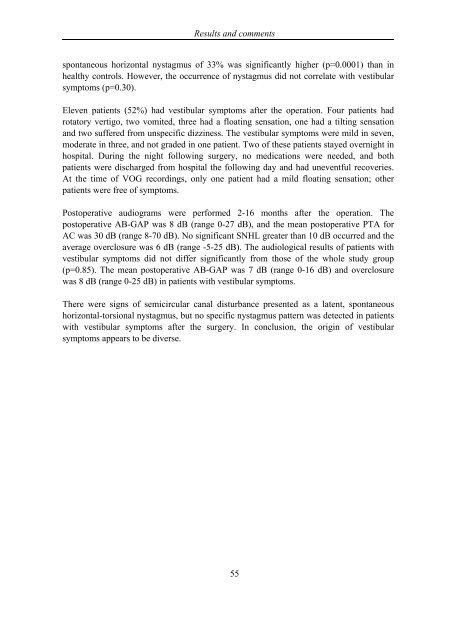Modern surgical treatment of otosclerosis - Helda - Helsinki.fi
Modern surgical treatment of otosclerosis - Helda - Helsinki.fi
Modern surgical treatment of otosclerosis - Helda - Helsinki.fi
Create successful ePaper yourself
Turn your PDF publications into a flip-book with our unique Google optimized e-Paper software.
Results and comments<br />
spontaneous horizontal nystagmus <strong>of</strong> 33% was signi<strong>fi</strong>cantly higher (p=0.0001) than in<br />
healthy controls. However, the occurrence <strong>of</strong> nystagmus did not correlate with vestibular<br />
symptoms (p=0.30).<br />
Eleven patients (52%) had vestibular symptoms after the operation. Four patients had<br />
rotatory vertigo, two vomited, three had a floating sensation, one had a tilting sensation<br />
and two suffered from unspeci<strong>fi</strong>c dizziness. The vestibular symptoms were mild in seven,<br />
moderate in three, and not graded in one patient. Two <strong>of</strong> these patients stayed overnight in<br />
hospital. During the night following surgery, no medications were needed, and both<br />
patients were discharged from hospital the following day and had uneventful recoveries.<br />
At the time <strong>of</strong> VOG recordings, only one patient had a mild floating sensation; other<br />
patients were free <strong>of</strong> symptoms.<br />
Postoperative audiograms were performed 2-16 months after the operation. The<br />
postoperative AB-GAP was 8 dB (range 0-27 dB), and the mean postoperative PTA for<br />
AC was 30 dB (range 8-70 dB). No signi<strong>fi</strong>cant SNHL greater than 10 dB occurred and the<br />
average overclosure was 6 dB (range -5-25 dB). The audiological results <strong>of</strong> patients with<br />
vestibular symptoms did not differ signi<strong>fi</strong>cantly from those <strong>of</strong> the whole study group<br />
(p=0.85). The mean postoperative AB-GAP was 7 dB (range 0-16 dB) and overclosure<br />
was 8 dB (range 0-25 dB) in patients with vestibular symptoms.<br />
There were signs <strong>of</strong> semicircular canal disturbance presented as a latent, spontaneous<br />
horizontal-torsional nystagmus, but no speci<strong>fi</strong>c nystagmus pattern was detected in patients<br />
with vestibular symptoms after the surgery. In conclusion, the origin <strong>of</strong> vestibular<br />
symptoms appears to be diverse.<br />
55

















